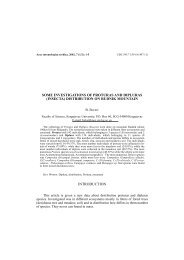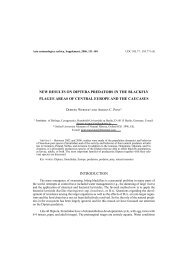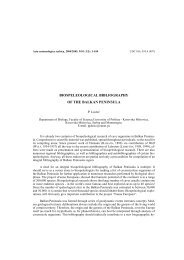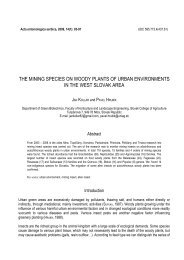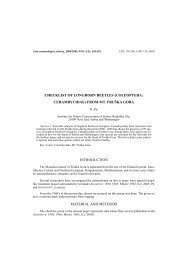Ćetković, A., Mokrousov, M., Plećaš, M., Bogusch, P., Antić, D ...
Ćetković, A., Mokrousov, M., Plećaš, M., Bogusch, P., Antić, D ...
Ćetković, A., Mokrousov, M., Plećaš, M., Bogusch, P., Antić, D ...
You also want an ePaper? Increase the reach of your titles
YUMPU automatically turns print PDFs into web optimized ePapers that Google loves.
Status of Asian Sceliphron spp. in Europe 103<br />
ĆETKOVIĆ et al. (2004) recorded that the local population in Vladimir Village (southern Montenegro) was<br />
apparently quite numerous in 2002, but already in 2003 no activity of this species in the same area could be<br />
detected. In the meantime, there was no opportunity to check for the presence of this species in Montenegro,<br />
until the last two seasons (2010-2011) when one of the co-authors (MK) tried to find it in the wider area of the<br />
Montenegrin coast (including Vladimir Village), without a positive result. Therefore, based on the current<br />
evidence, it seems that the establishment of the local population in southeastern Montenegro, although<br />
initially successful, failed to turn into a persistent colonisation and successive spreading north/westwards (we<br />
must stress, however, that our monitoring efforts may not be sufficient to assert the very conclusive judgment<br />
here).<br />
As elaborated by ĆETKOVIĆ et al. (2004), it is unlikely that the locality of the first record (Vladimir) was the<br />
place of initial establishment in the Balkans. This small settlement along the road that connects the most<br />
important Montenegrin port (the city of Bar) and the largest city in northern Albania (Shkodra) could be<br />
merely a point of an accidental secondary drop-out from the local transportation, originating from the primary<br />
colonisation area, probably in Albania. Regarding the relative paucity of data on Sphecidae from the Balkans,<br />
and particularly the fact that no record of any Hensenia species is known from Albania, FYR Macedonia, and<br />
most of the inland Greece and Montenegro, until recently we could have only hypothesised that some<br />
population(s) might exist somewhere else in the wider region of the first record. Eventually, this was<br />
corroborated with the most recent find from the northwestern Greek Island of Corfu, in June 2011. The island<br />
lies very close to the southern border of Albania, and the locality is about 260 km aerial distance from the<br />
Montenegrin record (Fig. 1, 2). This second record from the Balkans we consider as the decisive confirmation<br />
that S. deforme became effectively established in southeastern Europe, possibly more than 10 years ago;<br />
however, we cannot even roughly estimate the possible time of its initial arrival. Nevertheless, it seems<br />
obvious that its current rate of spreading is considerably lower than was established for the other introduced<br />
Hensenia species, and/or that its populations are by far less abundant, thus escaping detection.<br />
Some most recent data based on internet sources (photographs) suggests that further spreading of<br />
S. deforme into southern/eastern European Russia has happened, either from the Balkan or the<br />
Nizhegorodsky introduction stock. The reliability of photograph-based identification of the two Hensenia<br />
species is extensively elaborated in a separate paper (ĆETKOVIĆ et al., unpublished); hence, here we will use<br />
only some relevant outcomes from that study. Accordingly, the one specimen of Hensenia of the 3 listed in<br />
the ambiguous records section (“deforme or curvatum”), photographed in the southernmost part of the<br />
Russian Black Sea coast (in Sochi; by OGANESOV, 2009), we regard most probably to be S. deforme (of<br />
xanthic form). The other, more recent record from southeastern European Russia (Saratovskaya Oblast; by<br />
ZABALUEV, 2011), we also regard more likely to be S. deforme (of somewhat darker colour form) than<br />
S. curvatum, although the viewing angle offers less decisive distinguishing characters. The third ambiguous<br />
Russian record, based on the photograph from Voronezhskaya Oblast (by “KOLLEKCIONER”, 2011), more<br />
likely represents S. curvatum, but its poor quality prevents a decisive judgement. (Note, however, that we<br />
retained the labelling of all three respective localities for these important records as ‘ambiguous identity’, for<br />
now – in Figs. 1 & 3).<br />
Since we have also documented (herewith) the arrival of S. curvatum in the Sochi region and neighbouring<br />
areas along the Black Sea coast, the assumption of a likely S. deforme presence represents the second cooccurrence<br />
of the two alien Hensenia species in Europe. OGANESOV (2009) commented on his photo-posting<br />
for Sochi: “occurring there in the last 4 years, as quite numerous, particularly in comparison with<br />
S. destillatorium”; this may be interpreted as a possibility that any or both of the two Hensenia species could<br />
have arrived and become established in the area by 2005. The location of the putative Sochi record is about



